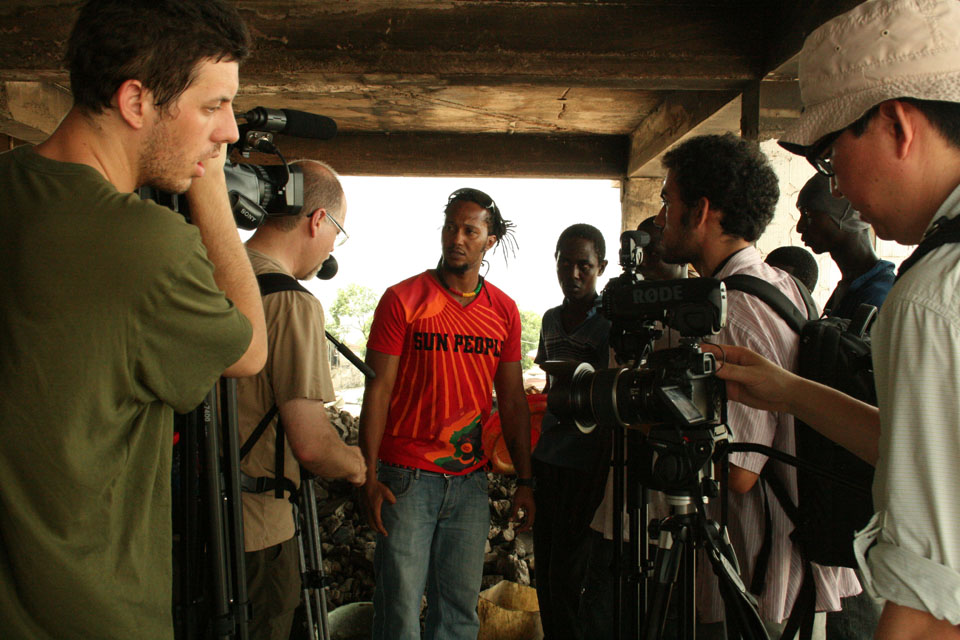Having spent the last two days working on the set of a real, live reggae video, I can now add “gaffa” to my CV.
I am someone with few, if any, practical visual media skills. So how did I end up on the production team for what might be the most polished music video to ever come out of Monrovia? The story starts, as the best ones always do, in the hotel bar.
Exhausted after a day of media training in the sticky Liberian summer, I was trudging through the bar to the dining room when Sayeed, the hotel manager, called me over. He was fiddling with wine bottles behind the counter, talking to a thin man with his hoodie up, fingers absently punching numbers on his mobile phone. He seemed very quiet, and pretty much ignored me completely.
Sayeed, on the other hand, did not. In fact, he seemed a little sloshed, and pretty intent on getting me obliterated right along with him. He regaled me, and the friend he introduced as Rabbie Nassrallah, with stories from his bartending days in the Emirates. Between demonstrating the bar tricks that had gotten him thrown into an Emirati jail (a long story), Sayeed told me that Rabbie was Liberia’s best reggae singer and that our team should help him conquer the global music industry. I, of course, immediately agreed that this was a fabulous idea.
Team-leader Ken Harper then sauntered up to the bar, and Sayeed called someone over to put Rabbie’s DVD of music clips onto the bar’s plasma screen. They were pretty great. Over the course of an hour’s conversation, Rabbie’s standoffishness had revealed itself to be shyness. He was an incredibly sweet guy with a gentle smile, thin rasta dreads framing high cheek bones and a small goatee. Then the video played.
The gentle, skinny-looking guy at the bar next to me was suddenly on the big screen, massive arm muscles bulging above orange prison-issue overalls, face snarling as he sang about how government policies were continuing to kill his people. Rabbie had stayed in Liberia when the war came; he would later tell some of our crew a little of what he had witnessed.
While his videos were impressive, he wanted to take them to the next level, and Sayeed had told him about the crew of camera-crazy American journalists staying in his hotel. It was quickly decided that Chris, our resident documentary maker and video-artist extraordinaire, should head up the project. In what I think now may be typical Rabbie style, when we hustled Chris over to the bar to meet him, it took Rabbie over an hour to talk to him about the project. By this time I was safely tucked up in bed, seeking shelter from Sayeed’s relentless re-filling of my wine glass.
So that is how I found myself the next night gripping a fluorescent light, trying to simulate candlelight by waggling my fingers in front of an orange cellophane-wrapped bulb. It is a lot harder than you’d think, and I felt pretty uncoordinated when it took me several takes to do. I mean, how hard is it to turn on a light bulb? But my team was very supportive, reiterating how important good lighting is to video work, and what a good job I’d done. Bless their kind hearts.
The video we were shooting was for a song called Bonkey. Bonkey is a local term for a corrupt person, and the song talked about how the practice had continued to impoverish the Liberian people. Rabbie had a firm vision of how he wanted the video to flow, and had rented out a music studio in the heart of Monrovia to film the first couple of scenes.
The opening shot was of him lighting a match to turn on a kerosene lamp (hence my finger waggling – Liberia has little electricity and mostly runs on generators). He hunched over scraps of paper, writing the lyrics to his song. On the desk in front of him lay old newspapers with screaming headlines, a book on Bob Marley and a copy of the Bible. The team shot this scene from many angles, and then it was time to shoot Rabbie recording his song in the studio.
This time, they wanted the orange-lighty-thing to be above Rabbie’s head while he sang. He took one look at me, and roped in one of his taller friends to do the job while I lounged on the couch in the other room. The poor man’s arms were shaking by the end of the scene.
Again the team shot Rabbie from several different angles, and called it a day a couple of hours later. This was an amazing experience for me, as I am only just beginning to learn about video, audio and photography. From a very selfish perspective, I know that I am incredibly lucky to be here, surrounded by people who are either experts, or quickly up-and-coming. It is genius by osmosis.
In the bigger picture, of course, I feel very privileged to be associated with a group of people who will so quickly jump to help someone get their career off the ground. The Together Liberia project is all about development communication – helping people to tell their own stories in their own voice. Rabbie Nass epitomizes this. He has experienced war, and sings about peace. He puts voice to social problems, and is highly political, but has made it clear that he doesn’t want to produce dark, violent music. He is a voice for social progress, a voice for change. I am so proud to have met him, and one day I’ll be cheering as I see him on MTV, or at the Grammy’s, shouting to anyone who will listen that I met Rabbie Nass in his hometown of Monrovia, before he conquered the world.


